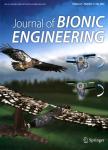Numerical Modelling of Electroosmotic Driven Flow in Nanoporous Media by Lattice Boltzmann Method
Numerical Modelling of Electroosmotic Driven Flow in Nanoporous Media by Lattice Boltzmann Method作者机构:Energy and Sustainability Research Division Faculty of Engineering University of Nottingham Nottingham NG7 2RD UK Key Laboratory of Bionic Engineering (Ministry of Education China) Jilin University Changchun 130022 P. R. China
出 版 物:《Journal of Bionic Engineering》 (仿生工程学报(英文版))
年 卷 期:2013年第10卷第1期
页 面:90-99页
核心收录:
学科分类:081704[工学-应用化学] 07[理学] 08[工学] 0817[工学-化学工程与技术] 082303[工学-交通运输规划与管理] 070302[理学-分析化学] 0703[理学-化学] 082302[工学-交通信息工程及控制] 0823[工学-交通运输工程]
基 金:supported by the following research grants: the UK EPSRC 2012 Pump Priming project, China NSFC under CSC PhD scholarship
主 题:electroosmotic flow electroosmotic pumping nanoporous media lattice Boltzmann method numerical modelling,anti-adhesion
摘 要:The lattice Boltzmann method was employed to simulate electroosmotic driven flow and Debye layer screening in con- ducting electrolyte around a porous structure with average size of 40 nm. The charge screening around the nanopores was investigated by solving the vector-superpositioned potential equilibrium distribution function and adding electro-kinetic force term to the evolution equation. In this intermediate case of moderate Debye length, the electrophoresis problem becomes complicated. The motion of the particles distorts the screening cloud, which becomes asymmetric, resulting in very complex interactions between the electrolyte, the screening cloud and the particle; but the Electroosmotic Flow (EOF) behaviour was still considered based on the Helmoholtz-Smoluchowski model with adaptation to fit nanoporous flow in the porous structure. In the present approach, the flow in the nanopores is directly modelled; the detailed flow information can be obtained by simplifying the repeated macrostructure. Due to the symmetry of the domain, the size of computational domain can be largely reduced by less repeated spherical nanoparticles. Each pore of the medium contains several lattice nodes on the simplified curved edges and potential gradients are produced by adjusting the zeta potential value. The velocity results for pressure-driven and EOF flows agree well with the analytical solutions and recent experimental results. In particular, the interface between solid particles and fluids, the influences of porosity, solid particle diameter, yield stress and electric parameters in EOF were investigated. The anti-adhesion effect of electroosmotic pumping effect was evaluated, and the pulsed DC was applied in order to enhance the performance of the electroosmotic pumping. The results demonstrate that the present lattice Boltzmann model is capable of modelling flow through nanoporous media at certain restrictions while some results deviate from the predictions based on the macr



